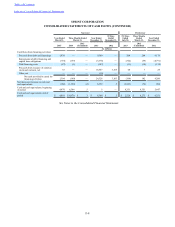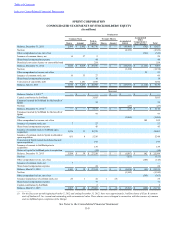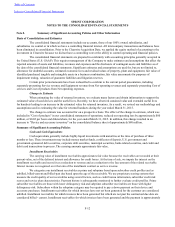Sprint - Nextel 2014 Annual Report Download - page 97
Download and view the complete annual report
Please find page 97 of the 2014 Sprint - Nextel annual report below. You can navigate through the pages in the report by either clicking on the pages listed below, or by using the keyword search tool below to find specific information within the annual report.
Table of Contents
Index to Consolidated Financial Statements
SPRINT CORPORATION
NOTES TO THE CONSOLIDATED FINANCIAL STATEMENTS
F-14
Long-Lived Asset Impairment
Sprint evaluates long-lived assets, including intangible assets subject to amortization, for impairment whenever
events or changes in circumstances indicate that the carrying amount of an asset group may not be recoverable. Asset groups
are determined at the lowest level for which identifiable cash flows are largely independent of cash flows of other groups of
assets and liabilities. When the carrying amount of a long-lived asset group is not recoverable and exceeds its fair value, an
impairment loss is recognized equal to the excess of the asset group’s carrying value over the estimated fair value. See Note
6. Property, Plant and Equipment for additional information on long-lived asset impairments.
Certain assets that have not yet been deployed in the business, including network equipment, cell site development
costs and software in development, are periodically assessed to determine recoverability. Network equipment and cell site
development costs are expensed whenever events or changes in circumstances cause the Company to conclude the assets are
no longer needed to meet management's strategic network plans and will not be deployed. Software development costs are
expensed when it is no longer probable that the software project will be deployed. Network equipment that has been removed
from the network is also periodically assessed to determine recoverability. If we experience significant operational
challenges, including retaining and attracting subscribers, future cash flows of the Company may not be sufficient to recover
the carrying value of our wireless asset group, and we could record asset impairments that are material to Sprint's
consolidated results of operations and financial condition.
Indefinite-Lived Intangible Assets
Our indefinite-lived intangible assets primarily consist of goodwill, certain of our trademarks and FCC licenses.
Goodwill represents the excess of consideration paid over the estimated fair value of the net tangible and identifiable
intangible assets acquired in business combinations. In determining whether an intangible asset, other than goodwill, is
indefinite-lived, we consider the expected use of the assets, the regulatory and economic environment within which they are
being used, and the effects of obsolescence on their use. We assess our indefinite-lived intangible assets, including goodwill,
for impairment at least annually or, if necessary, more frequently, whenever events or changes in circumstances indicate the
asset may be impaired.
These analyses, which include the determination of fair value, require considerable judgment and are highly
sensitive to changes in underlying assumptions. Consequently, there can be no assurance that the estimates and assumptions
made for the purposes of estimating the fair values of our indefinite-lived assets, including goodwill, will prove to be an
accurate prediction of the future. Continued, sustained declines in the Company’s operating results, future forecasted cash
flows, growth rates and other assumptions, as well as significant, sustained declines in the Company’s stock price and related
market capitalization could impact the underlying key assumptions and our estimated fair values, potentially leading to a
future material impairment of goodwill or other indefinite-lived intangible assets. See Note 7. Intangible Assets for additional
information on indefinite-lived intangible asset impairments.
Guarantee Liabilities
Under certain of our wireless service plans, we offer an option to our subscribers to purchase, on a monthly basis,
an annual trade-in right (the option). At the trade-in date, a subscriber, who has elected to purchase a device in an installment
billing arrangement, will receive a credit in the amount of the outstanding balance of the remaining installment payments
provided the subscriber trades-in an eligible used device in good working condition and purchases a new device from Sprint.
Additionally, the subscriber must have purchased the option for the twelve consecutive months preceding the trade-in. When
a subscriber elects the option, the total estimated arrangement proceeds associated with the subscriber are reduced by the
estimated fair value of the fixed-price trade-in credit (guarantee liability) and the remaining proceeds are allocated amongst
the other deliverables in the arrangement. The guarantee liability is estimated based on assumptions, including, but not
limited to, the expected fair value of the used device at trade-in, subscribers’ estimated remaining balance of the installment
receivable, and the probability and timing of the trade-in. When the subscriber elects to exercise the trade-in right, the
difference between the outstanding balance of the installment receivable and the estimated fair value of the returned device is
recorded as a reduction of the guarantee liability. If the subscriber elects to stop purchasing the option prior to, or after,
becoming eligible to exercise the trade-in right, we recognize the amount of the associated guarantee liability as operating
revenue. At each reporting date, we reevaluate our estimate of the guarantee liability. If all subscribers, who elected the
option, were to claim their benefit at the earliest contractual time of eligible trade-in, the maximum amount of the guarantee
























